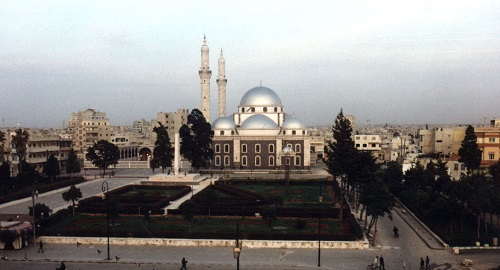Khaled Ibn alWalid Mosque in Homs is a Wonder of Islamic architecture. North of Homs’ city center, and on a space relatively higher than its neighborhood, stands the Mosque of the Prophet’s Companion and the Moslem commander Khaled Ibn alWalid, which enshrines his tomb and adds a sense of calm, light, and spiritual radiance to the area. The mosque is considered one of the wonders of Islamic architecture and an important historical site whose visit is always sought by Arab and foreign tourists whenever they visit Homs.
The mosque stands firmly boasting its two slender minarets which climb high into the sky to remind worshippers of the God the Creator, and to call the believers for prayers. Five domes and four semi domes, characterized by a balanced shape, make the roof of the mosque and add grandeur to its image. These domes are based on internal columns and on the outer Ablaq walls built of alternative rows of black and white lime stones. “Sidi Khaled”, as the residents of Homs used to call him, is considered the typical warrior, or in a better expression, the liberator and conqueror, because he liberated Damascus in 635 AD, and liberated Homs peacefully in 637, and we can say that he is the one who brought Islam to the city and secured it after its conquest. Khaled Ibn alWalid has a distinguished relation with the city so it is labeled now the “City of Ibn alWalid”, and he is always mentioned as Sidi Khaled, i.e. Master Khaled.
History of the Mosque
Many historical references mention that the place where Khaled Ibn alWalid was buried is the village of alKhaldieh, 1500m from the center of the old city of Homs, which is now one of the biggest quarters of Homs proper. These references also say that the first one who took care of changing the tomb of the great commander into a mosque that fits his fame and position in Islam was the Sultan alZaher Baibars, when he crossed Homs in 1266 AD to attack the city of Sis, after his two victories in Ein Jalout against the Mongols, and in Safad against the Crusaders. He allocated one of the villages of Safad as an endowment to build the mosque. Two historical notes written on wooden plates dating to the year 664 Hijira=1266 AD document the history of the mosque, the first was found fixed on a wooden gate and the second of five lines was engraved on a wooden board.
The present mosque was built in the late period of the Ottoman rule. It was built over the bases of the original mosque which was built along the Mamelouk style during the reign of alZaher Baibars.
During the rule of Sultan Abdulhamid II, the governor of Damascus Nazem Pacha could obtain a decree from the Sublime Porte to renew the mosque. It was said that Nazem Pacha convinced the Ottoman Sultan to grant him two sums of money; the first was 10 000 Ottoman Dinars, and the second 6000 Dinars, and the costs of building were supplemented by the gifts and jewelry which were found on the tomb. When the mosque was renewed in 1931 it was characterized by the Byzantine – Ottoman architecture which reminds us of Istanbul’s mosques, the Church of Ayasofia, Iderne Mosque and the Mosque of Mohammad the Conqueror. Researcher Mohammad Faisal Sheikhani, in his book” Homs and its Khaled” says that sultan Abdulhamid wanted to allocate more money to cover inner walls with qashani tiles similar to the walls of the mosque of Mohmmad The Conqueror, but he was removed from power before he could do that. In 1909 Sultan Mohammad Rashad took power, but he did not care for the mosque, which was completed by the donations of Homs residents. In 1895-1900, a decree was issued ordering Abdulhamid Pacha alDroubi, Municipal of Homs to continue building the mosque.
Haifaa Mafalani

